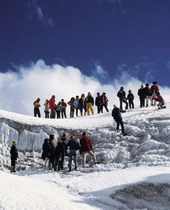In Peru, nature appears to have taken on particular characteristics which have turned its mountains, plains, jungles and valleys into unique habitats.
An extraordinary variety of eco-systems shelters a wide diversity of animals and plants.
An extraordinary variety of eco-systems shelters a wide diversity of animals and plants.
The Coast
Which features deserts, beautiful beaches and fertile valleys…
The Peruvian coastline is formed by a long snaking desert hemmed in between the sea and the mountains. The Andes to the east and the cold Humboldt sea current that runs along the coast are what make this area so arid. From the Sechura desert to the Nazca plains and the Atacama desert, the dry coastal terrain is occasionally split by valleys covered by a thick layer of cloud and drizzle in the winter.
Humidity in these areas produces a sensation of cold, although temperatures rarely dip below 12°C. During the summer, meanwhile, the sun beats down and temperatures often top 30°C. The central and southern sections of the coast feature two well-defined seasons: winter from April to October, and summer from November to March. The north coast, meanwhile, is not touched by the effects of the cold current, which means it enjoys 300 days of sunshine a year and warm temperatures all year-long (as much as 35°C in the summer).

The Peruvian coastline is formed by a long snaking desert hemmed in between the sea and the mountains. The Andes to the east and the cold Humboldt sea current that runs along the coast are what make this area so arid. From the Sechura desert to the Nazca plains and the Atacama desert, the dry coastal terrain is occasionally split by valleys covered by a thick layer of cloud and drizzle in the winter.
Humidity in these areas produces a sensation of cold, although temperatures rarely dip below 12°C. During the summer, meanwhile, the sun beats down and temperatures often top 30°C. The central and southern sections of the coast feature two well-defined seasons: winter from April to October, and summer from November to March. The north coast, meanwhile, is not touched by the effects of the cold current, which means it enjoys 300 days of sunshine a year and warm temperatures all year-long (as much as 35°C in the summer).
The Highlands
A mountainous area dominated by the Andes, where Mount Huascaran soars to 6,768 meters…
In the Peruvian highlands, there are two well-defined seasons: the dry season (from April to October), marked by sunny days, cold nights and the lack of rain (the ideal time for visiting); and the rainy season (November to March), when there are frequent rain showers (generally more than 1000 mm). A characteristic of the mountain region is the drop in temperature during the day: temperatures commonly range around 24°C at midday before plunging to -3°C at night.
The Jungle
A vast region of tropical vegetation in the Amazon River Basin, home to Peru’s largest natural reserves…
reserves…
 reserves…
reserves…The vast Peruvian jungle, which surrounds the wide and winding Amazon river, is divided into two differentiated areas: the cloud forest (above 700 masl), which features a subtropical, balmy climate, with heavy rain showers (around 3000 mm a year) between November and March, and sunny days from April to October; and the lowland jungle (below 700 masl), where the dry season runs from April to October and is ideal for tourism, with sunshine and high temperatures often topping 35°C
